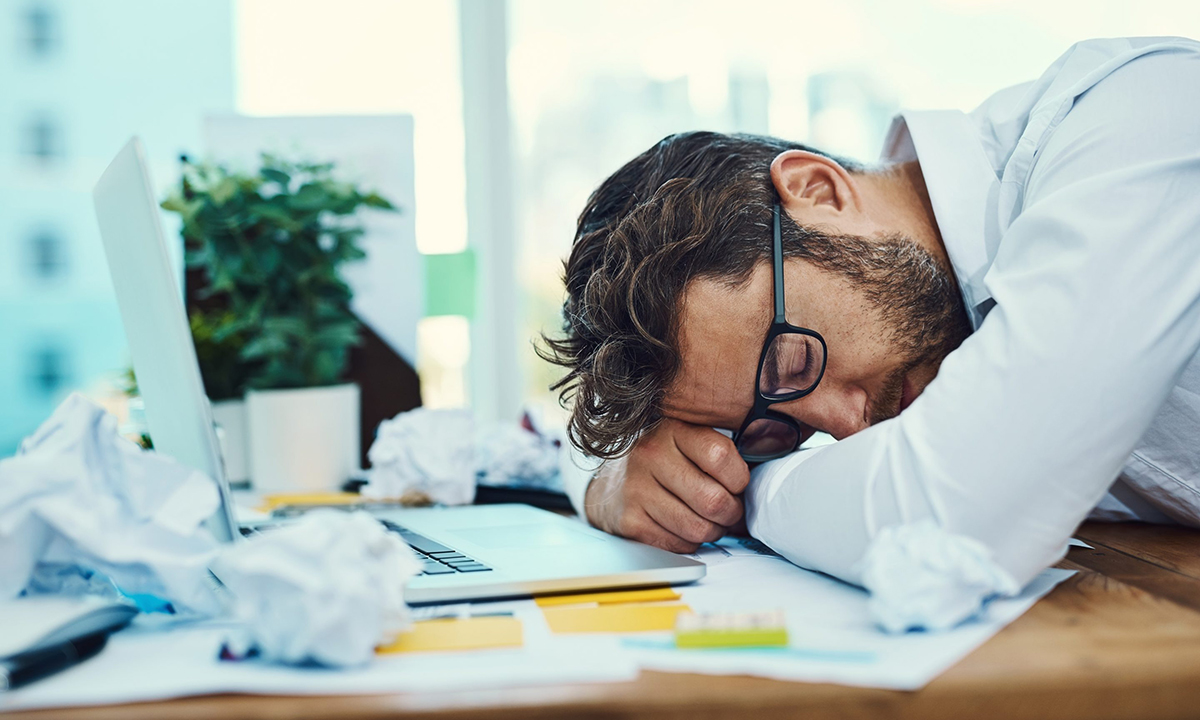
我大三那年是在西班牙留學(xué)的,。我很快就適應(yīng)了那里的午休文化,也就是午飯后休息兩三個(gè)小時(shí),。在西班牙語(yǔ)里,,午休和午睡是一回事兒,午休是工作日的分水嶺,,基本上所有企業(yè)在下午2點(diǎn)到5點(diǎn)之間都是關(guān)門(mén)的,。
一開(kāi)始的時(shí)候,西班牙的午休文化讓我這個(gè)“內(nèi)卷”慣了的工作狂有些不適應(yīng),。不過(guò)它很快就成為了我留學(xué)生活中的一部分,。只是回國(guó)之后,我很快又把午休的習(xí)慣拋到一邊了,。
過(guò)了將近20年后,,午休的習(xí)慣又在美國(guó)流行了起來(lái),這還要感謝The Nap Ministry的創(chuàng)始人特里西婭·赫西,她堅(jiān)持不懈地宣傳午休的好處,,而且科學(xué)研究也表明午睡有助于改善人的整體健康水平,。最近的一項(xiàng)研究發(fā)現(xiàn),午睡能夠延緩大腦隨著年齡增長(zhǎng)而萎縮的速度,,從而促進(jìn)大腦健康,。
午睡的好處還包括:
? 提高記憶力
? 提高警覺(jué)性
? 提高邏輯思維能力
? 降低疲勞
當(dāng)然,什么事情都是有利有弊,,對(duì)于午睡也是一樣,。下面就來(lái)說(shuō)說(shuō)上班族們正確的午睡打開(kāi)方式。
一天什么時(shí)候午睡最合適
在你午睡之前,,你應(yīng)該設(shè)置一個(gè)30分鐘的鬧鐘,,因?yàn)檫^(guò)長(zhǎng)的午睡時(shí)間會(huì)影響你夜間的睡眠質(zhì)量,讓你第二天感覺(jué)更加疲勞,,甚至有可能造成惡性循環(huán),。
睡眠咨詢服務(wù)公司Sleepless in NOLA的創(chuàng)始人尼龍·維亞斯博士建議:“每天午睡時(shí)間應(yīng)該限制在30分鐘以內(nèi),而且應(yīng)該早于夜間上床時(shí)間至少7個(gè)半小時(shí)到9個(gè)小時(shí),,以避免擾亂夜間睡眠和晝夜節(jié)律,。如果你打算在白天午睡,最好的時(shí)間就是在喝完咖啡或者吃完午飯以后,?!?/p>
如果每天午睡超過(guò)60分鐘,則會(huì)增加患2型糖尿病或代謝綜合癥的風(fēng)險(xiǎn),,而代謝問(wèn)題則有可能會(huì)增加你患心臟病,、糖尿病、中風(fēng)和其他健康問(wèn)題的風(fēng)險(xiǎn),。
午睡的理想環(huán)境
午睡的理想環(huán)境與夜間睡眠相似,,專家建議盡量選擇一個(gè)黑暗和安靜的環(huán)境,并且盡可能減少干擾,。當(dāng)然,,如果你不是居家辦公,或者你的公司沒(méi)有專門(mén)的午休場(chǎng)所,,要想創(chuàng)造這樣的環(huán)境可能并不容易,。
倫敦大學(xué)學(xué)院(University College London)的維多利亞·加菲爾德博士在關(guān)于午休與腦健康的一項(xiàng)研究中指出:“我們的研究結(jié)果表明,對(duì)于部分人來(lái)說(shuō),,午休有助于在年齡增長(zhǎng)的過(guò)程中保持大腦健康,。我希望類似研究有助于消除人們對(duì)午休的偏見(jiàn)?!保ㄘ?cái)富中文網(wǎng))
譯者:樸成奎
我大三那年是在西班牙留學(xué)的,。我很快就適應(yīng)了那里的午休文化,也就是午飯后休息兩三個(gè)小時(shí)。在西班牙語(yǔ)里,,午休和午睡是一回事兒,,午休是工作日的分水嶺,基本上所有企業(yè)在下午2點(diǎn)到5點(diǎn)之間都是關(guān)門(mén)的,。
一開(kāi)始的時(shí)候,西班牙的午休文化讓我這個(gè)“內(nèi)卷”慣了的工作狂有些不適應(yīng),。不過(guò)它很快就成為了我留學(xué)生活中的一部分,。只是回國(guó)之后,我很快又把午休的習(xí)慣拋到一邊了,。
過(guò)了將近20年后,,午休的習(xí)慣又在美國(guó)流行了起來(lái),這還要感謝The Nap Ministry的創(chuàng)始人特里西婭·赫西,,她堅(jiān)持不懈地宣傳午休的好處,,而且科學(xué)研究也表明午睡有助于改善人的整體健康水平。最近的一項(xiàng)研究發(fā)現(xiàn),,午睡能夠延緩大腦隨著年齡增長(zhǎng)而萎縮的速度,,從而促進(jìn)大腦健康。
午睡的好處還包括:
? 提高記憶力
? 提高警覺(jué)性
? 提高邏輯思維能力
? 降低疲勞
當(dāng)然,,什么事情都是有利有弊,,對(duì)于午睡也是一樣。下面就來(lái)說(shuō)說(shuō)上班族們正確的午睡打開(kāi)方式,。
一天什么時(shí)候午睡最合適
在你午睡之前,,你應(yīng)該設(shè)置一個(gè)30分鐘的鬧鐘,因?yàn)檫^(guò)長(zhǎng)的午睡時(shí)間會(huì)影響你夜間的睡眠質(zhì)量,,讓你第二天感覺(jué)更加疲勞,,甚至有可能造成惡性循環(huán)。
睡眠咨詢服務(wù)公司Sleepless in NOLA的創(chuàng)始人尼龍·維亞斯博士建議:“每天午睡時(shí)間應(yīng)該限制在30分鐘以內(nèi),,而且應(yīng)該早于夜間上床時(shí)間至少7個(gè)半小時(shí)到9個(gè)小時(shí),,以避免擾亂夜間睡眠和晝夜節(jié)律。如果你打算在白天午睡,,最好的時(shí)間就是在喝完咖啡或者吃完午飯以后,。”
如果每天午睡超過(guò)60分鐘,,則會(huì)增加患2型糖尿病或代謝綜合癥的風(fēng)險(xiǎn),,而代謝問(wèn)題則有可能會(huì)增加你患心臟病、糖尿病,、中風(fēng)和其他健康問(wèn)題的風(fēng)險(xiǎn),。
午睡的理想環(huán)境
午睡的理想環(huán)境與夜間睡眠相似,專家建議盡量選擇一個(gè)黑暗和安靜的環(huán)境,并且盡可能減少干擾,。當(dāng)然,,如果你不是居家辦公,或者你的公司沒(méi)有專門(mén)的午休場(chǎng)所,,要想創(chuàng)造這樣的環(huán)境可能并不容易,。
倫敦大學(xué)學(xué)院(University College London)的維多利亞·加菲爾德博士在關(guān)于午休與腦健康的一項(xiàng)研究中指出:“我們的研究結(jié)果表明,對(duì)于部分人來(lái)說(shuō),,午休有助于在年齡增長(zhǎng)的過(guò)程中保持大腦健康,。我希望類似研究有助于消除人們對(duì)午休的偏見(jiàn)?!保ㄘ?cái)富中文網(wǎng))
譯者:樸成奎
When I studied abroad in Spain my junior year of college, I quickly became adept at the siesta—a two- to three-hour midday break, usually following lunch. Directly translated, siesta is Spanish for “nap,” but the tradition also involves a workday pause, with businesses shutting down between 2 p.m. and 5 p.m.
At first, the siesta caught my American workaholic tendencies off guard. But the cultural norm quickly grew to become a cherished part of my time abroad, although the practice fell by the wayside once I returned stateside.
Fast forward nearly 20 years later and naps are having a moment on this side of the Atlantic thanks in large part to Tricia Hersey of The Nap Ministry, who preaches and practices the examines the liberating power of naps, and science that proves napping can improve overall health. In fact, a recent study found that power napping can promote better brain health by slowing the rate at which brains shrink as we age.
Other benefits of daytime napping include:
? Improved memory
? Increased alertness
? Better logical reasoning abilities
? Reduced fatigue
But as with most practices, there are pros and cons to daytime napping. Here’s how to make sure you incorporate naps into your workday routine effectively.
The best time of day to take a nap
Before you doze off, you’ll want to ensure you set an alarm for 30 minutes out as longer naps interfere with your ability to sleep well at night, causing you to feel more tired and perpetuating a cycle of poor sleep.
“Taking a nap can be helpful as long as it is limited to 30 minutes per day and completed at least seven and a half to nine hours before bedtime to avoid disrupting overnight sleep and circadian rhythms,” explains Dr. Nilong Vyas, founder and owner of Sleepless in NOLA, a sleep consulting service, and medical review expert at SleepFoundation.org. “If you decide to nap during the day, it’s best to do so earlier in the morning after drinking coffee or lunch.”
Daily naps lasting longer than 60 minutes have been linked to an increased risk of type 2 diabetes or metabolic syndrome, a group of conditions that can raise your risk of heart diseases, diabetes, stroke and other health concerns.
The ideal environment for a nap
Prime conditions for napping are similar to nighttime sleep, with experts recommending a dark and quiet space with minimal interruptions and distractions. However, creating such a space could prove difficult if you aren’t working from home or don’t work for a company that has incorporated dedicated napping facilities into its workspace.
“Our findings suggest that, for some people, short daytime naps may be a part of the puzzle that could help preserve the health of the brain as we get older,” Dr. Victoria Garfield of University College London wrote in her study about naps and brain health. “I hope studies such as this one showing the health benefits of short naps can help to reduce any stigma that still exists around daytime napping.”






